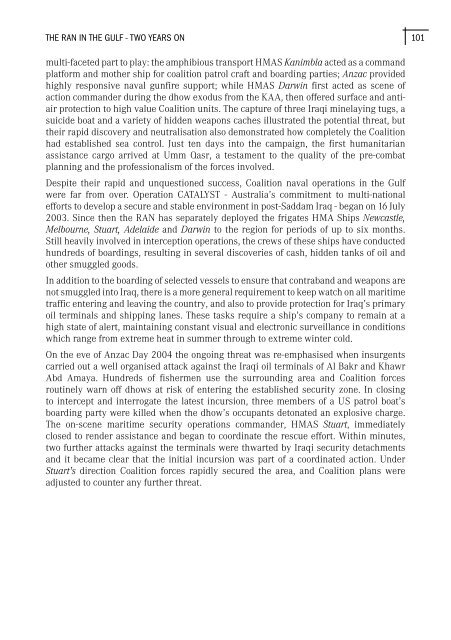Australian Maritime Issues 2005 - Royal Australian Navy
Australian Maritime Issues 2005 - Royal Australian Navy
Australian Maritime Issues 2005 - Royal Australian Navy
You also want an ePaper? Increase the reach of your titles
YUMPU automatically turns print PDFs into web optimized ePapers that Google loves.
THE RAN IN THE GULF - TWO YEARS ON<br />
101<br />
multi-faceted part to play: the amphibious transport HMAS Kanimbla acted as a command<br />
platform and mother ship for coalition patrol craft and boarding parties; Anzac provided<br />
highly responsive naval gunfire support; while HMAS Darwin first acted as scene of<br />
action commander during the dhow exodus from the KAA, then offered surface and antiair<br />
protection to high value Coalition units. The capture of three Iraqi minelaying tugs, a<br />
suicide boat and a variety of hidden weapons caches illustrated the potential threat, but<br />
their rapid discovery and neutralisation also demonstrated how completely the Coalition<br />
had established sea control. Just ten days into the campaign, the first humanitarian<br />
assistance cargo arrived at Umm Qasr, a testament to the quality of the pre-combat<br />
planning and the professionalism of the forces involved.<br />
Despite their rapid and unquestioned success, Coalition naval operations in the Gulf<br />
were far from over. Operation CATALYST - Australia’s commitment to multi-national<br />
efforts to develop a secure and stable environment in post-Saddam Iraq - began on 16 July<br />
2003. Since then the RAN has separately deployed the frigates HMA Ships Newcastle,<br />
Melbourne, Stuart, Adelaide and Darwin to the region for periods of up to six months.<br />
Still heavily involved in interception operations, the crews of these ships have conducted<br />
hundreds of boardings, resulting in several discoveries of cash, hidden tanks of oil and<br />
other smuggled goods.<br />
In addition to the boarding of selected vessels to ensure that contraband and weapons are<br />
not smuggled into Iraq, there is a more general requirement to keep watch on all maritime<br />
traffic entering and leaving the country, and also to provide protection for Iraq’s primary<br />
oil terminals and shipping lanes. These tasks require a ship’s company to remain at a<br />
high state of alert, maintaining constant visual and electronic surveillance in conditions<br />
which range from extreme heat in summer through to extreme winter cold.<br />
On the eve of Anzac Day 2004 the ongoing threat was re-emphasised when insurgents<br />
carried out a well organised attack against the Iraqi oil terminals of Al Bakr and Khawr<br />
Abd Amaya. Hundreds of fishermen use the surrounding area and Coalition forces<br />
routinely warn off dhows at risk of entering the established security zone. In closing<br />
to intercept and interrogate the latest incursion, three members of a US patrol boat’s<br />
boarding party were killed when the dhow’s occupants detonated an explosive charge.<br />
The on-scene maritime security operations commander, HMAS Stuart, immediately<br />
closed to render assistance and began to coordinate the rescue effort. Within minutes,<br />
two further attacks against the terminals were thwarted by Iraqi security detachments<br />
and it became clear that the initial incursion was part of a coordinated action. Under<br />
Stuart’s direction Coalition forces rapidly secured the area, and Coalition plans were<br />
adjusted to counter any further threat.

















